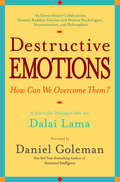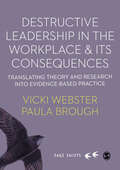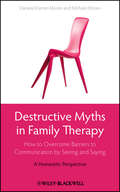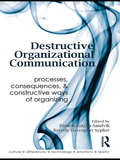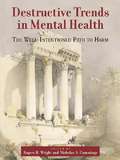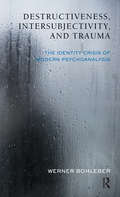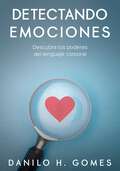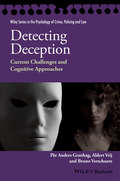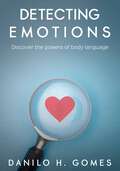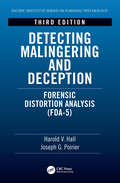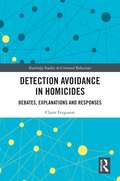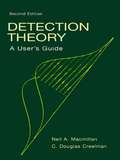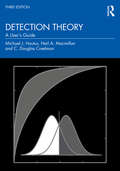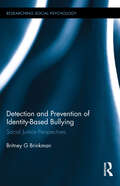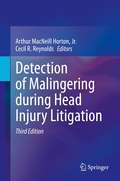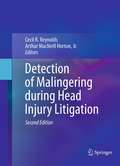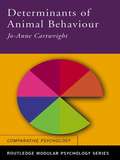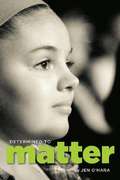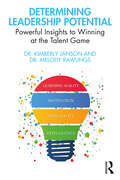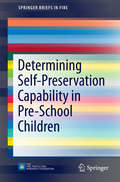- Table View
- List View
Destructive EMOTIONS: A Scientific Dialogue with the Dalai Lama
by Daniel GolemanBringing together ancient Buddhist wisdom and recent breakthroughs in a wide variety of fields from neuroscience to child development, Daniel Goleman's new book offers fresh insights into how we can recognize and transform the destructive emotions that pose grave dangers to our individual and collective fate. Out of a week long discussion between the Dalai Lama and leading figures from the worlds of neruoscience and psychology, Daniel Goleman weaves together a compelling narrative account of what the destructive emotions are, where they come from, how the child and then the adult brain is shaped, how these destructive emotions (craving, anger and delusion, known in Buddhism as the three poisons) can be transformed and how they must be transformed if they are not to threaten humanity's collective safety and its future. DESTRUCTIVE EMOTIONS is a timely and important book
Destructive Leadership in the Workplace and its Consequences: Translating theory and research into evidence-based practice (SAGE Swifts)
by Paula brough Vicki WebsterWith relevance across public, private and not-for-profit sectors, and combining perspectives from both the business and psychology worlds, this book is a cross-disciplinary look at how destructive leaders can impact organisations and their workers, and how best to recognise and deal with them. This text bridges the gap between the theory and the practical application, by taking the academic research and translating this for students, managers and practitioners in the field into practicable interventions they can use in their everyday practice to recognise and resolve issues raised by destructive leaders. Using case studies throughout, this guide takes the theory and places it in the real world, helping readers take the theory beyond the page and apply it to their practice.
Destructive Leadership in the Workplace and its Consequences: Translating theory and research into evidence-based practice (SAGE Swifts)
by Paula brough Vicki WebsterWith relevance across public, private and not-for-profit sectors, and combining perspectives from both the business and psychology worlds, this book is a cross-disciplinary look at how destructive leaders can impact organisations and their workers, and how best to recognise and deal with them. This text bridges the gap between the theory and the practical application, by taking the academic research and translating this for students, managers and practitioners in the field into practicable interventions they can use in their everyday practice to recognise and resolve issues raised by destructive leaders. Using case studies throughout, this guide takes the theory and places it in the real world, helping readers take the theory beyond the page and apply it to their practice.
Destructive Myths in Family Therapy
by Michael Moore Daniela Kramer-MooreExposes destructive patterns of communication within family cultures and provides strategies for promoting more open dialogue among family members. Equips family therapists to help clients see the barriers they place in the way of healthy communication, and adopt more constructive alternatives Provides activities designed to spark open dialogue between therapist and clients, strengthening the therapeutic relationship and facilitating family interaction Includes communication strategies for reversing disengagement, defusing power struggles, overcoming sibling rivalry, disentangling marital problems and more Offers a new understanding of family dynamics, an area in which many family therapists want to improve their skills but have struggled to find a text to guide them in doing so
Destructive Organizational Communication: Processes, Consequences, and Constructive Ways of Organizing (Routledge Communication Series #Vol. 10)
by Pamela Lutgen-Sandvik Beverly Davenport SypherThis volume provides an in-depth consideration of destructive communication in organizations -- including workplace bullying, racism, stress, and harassment. It brings together communication scholars from theoretical and applied perspectives to assess current understandings, explore ways to integrate theory and practice, identify areas for change, and outline a research agenda for the coming decade. Each chapter examines a specific aspect of destructive organizational communication, reviews existing theory and research about that communicative form or ideology, suggests fruitful possibilities for application, and suggests key areas for further study. As such, the book opens a dialogue among communication scholars that explores destructive communication in organizations and addresses the following key components: the central issues and concerns regarding destructive organizational communication, current scholarly contributions to both applied and theoretical understanding of these issues, approaches to integrate applied/experienced and theoretical/conceptual perspectives in ways that inform one another and improve organizational considerations for varied stakeholders, and suggestions for a future research agenda for those interested in ameliorating the destructive side of organizational communication. Overall, the collection provides a basic understanding of the different types of destructive communication in organizations, the processes through which these interactions occur, the consequences to individuals and organizations, and the potential for organizing in more constructive, civil ways. This volume will be an excellent resource for scholars and researcher studying organizational communication, and graduate and advanced undergraduate students in organizational communication. It will also resonate with managers dealing with hostile workplaces, and organizational members trying to understand their current experiences. The book will serve as an excellent textbook for advanced undergraduate and graduate courses in organizational communication.
Destructive Trends in Mental Health: The Well Intentioned Path to Harm
by Nicholas A. Cummings Rogers H. WrightThis book takes as its inspiration the assumption that the atmosphere of intellectual openness, scientific inquiry, aspiration towards diversity, and freedom from political pressure that once flourished in the American Psychological Association has been eclipsed by an "ultra-liberal agenda," in which voices of dissent, controversial points of view, and minority groups are intimidated, ridiculed and censored. Chapters written by established and revered practitioners explore these important issues within the contexts of social change, the ways in which mental health services providers view themselves and their products, and various economic factors that have affected healthcare cost structure and delivery. In short, this book is intended to help consumers, practitioners, and policy makers to become better educated about a variety of recent issues and trends that have significantly changed the mental health fields.
Destructiveness, Intersubjectivity and Trauma: The Identity Crisis of Modern Psychoanalysis (The\developments In Psychoanalysis Ser.)
by Werner Bohleber'At last we have a book that provides a comprehensive overview and assessment of the intersubjective turn in psychoanalysis, showing its logical and clinical limitations and exploring its social and cultural determinants. Bohleber emphasizes the clinical importance of real traumatic experience along with the analysis of the transference as he reviews and broadens psychoanalytic theories of memory in relation to advances in cognitive psychology and neuroscience. Psychoanalytic ideas on personality, adolescence and identity are re-thought and updated. Bohleber brilliantly presents a unique understanding of malignant narcissism and prejudice in relation to European anti-Semitism and to contemporary religiously inspired terrorist violence.'- Cyril Levitt, Dr Phil, Professor and former Chair Department of Sociology, McMaster University Hamilton, Ontario. Psychoanalyst in private practice, Toronto, Ontario
Detachment and Enabling
by Rebecca D. Chaitin Judith M KnowltonDetachment and Enabling combines two classic, user-friendly texts designed for loved ones of addicts and alcoholics.Detachment and Enabling combines two classic, user-friendly texts designed for loved ones of addicts and alcoholics. After you have done all you can to help a chemically dependent person and he or she continues to drink or use, it's time to detach. Detachment tells us how we can continue to love someone who is chemically dependent and, at the same time, no longer focus on that person's behavior. It is about taking back our lives.Enabling describes the problems we can encounter when we focus on the alcoholic or addict in order to keep peace at any price. The authors encourage us to consider if we are really helping the alcoholic or ourselves when we prevent the alcoholic from feeling the true consequences of his or her actions.About the authors: Judith M. Knowlton has a degree in psychology from Oberlin College and her master's in Group Process from Seton Hall University. A recovering alcoholic, she is a Certified Alcoholism Counselor with then years/' experience. Judy has been instrumental in starting several alcoholism programs in northern New Jersey. She is the founder of Action for Sobriety Groups, president of Quotidian, and the mother of three adult children.Rebecca D. Chaitin is a writer and editor, part-time alcoholism counselor, and recovering alcoholic. Born in Virginia, she is graduate of Hollins College and worked for various New York publishers, including Time-Life Books, before she began freelancing in the early 1970s. She now lives in Montclair, New Jersey, with her three teenagers.
Detectando Emociones: Descubra los poderes del lenguaje corporal
by Danilo H. GomesAprenda a través de este libro, a “detectar” las emociones escondidas en cada gesto humano. Fruto de muchas búsquedas, “Detectando Emociones” es un óptimo libro para quien quiera aprender, de forma rápida e directa, los significados escondidos por atrás de cada movimiento humano. Mas allá de eso también aprenda, a través de la Proxémica, el significado escondido por atrás de la distancia que un individuo permanece en relación con otro durante una simple conversación. Qué tal conocer también las técnicas usadas para descubrir una mentira. Ellas también están presentes en este libro. Aprenda 17 señales sospechosas que revelan una mentira. Esto y mucho más usted encontrará en las páginas de este humilde libro. Ciencia pura, sin complicaciones.
Detecting Deception: Current Challenges and Cognitive Approaches (Wiley Series in Psychology of Crime, Policing and Law)
by Aldert Vrij Pär Anders Granhag Bruno VerschuereDetecting Deception offers a state-of-the-art guide to the detection of deception with a focus on the ways in which new cognitive psychology-based approaches can improve practice and results in the field. Includes comprehensive coverage of the latest scientific developments in the detection of deception and their implications for real-world practice Examines current challenges in the field - such as counter-interrogation strategies, lying networks, cross-cultural deception, and discriminating between true and false intentions Reveals a host of new approaches based on cognitive psychology with the potential to improve practice and results, including the strategic use of evidence, imposing cognitive load, response times, and covert lie detection Features contributions from internationally renowned experts
Detecting Emotions: Discover the powers of body language
by Danilo H. GomesThis book is for anyone with curiosity about reading the body language. It is a description of body reactions during a conversations and how we can read them with their meanings singular. Also, this book is for the ones who want to improve their abilities to help those in need with depression, anxiety and deep sadness. This is the perfect reading for those who feel like getting to know more about this fascinating content.
Detecting Lies and Deceit
by Aldert VrijWhy do people lie?Do gender and personality differences affect how people lie?How can lies be detected?Detecting Lies and Deceit provides the most comprehensive review of deception to date. This revised edition provides an up-to-date account of deception research and discusses the working and efficacy of the most commonly used lie detection tools, including:Behaviour Analysis InterviewStatement Validity AssessmentReality MonitoringScientific Content AnalysisSeveral different polygraph testsVoice Stress AnalysisThermal ImagingEEG-P300Functional Magnetic Resonance Imaging (fMRI)All three aspects of deception are covered: nonverbal cues, speech and written statement analysis and (neuro)physiological responses. The most common errors in lie detection are discussed and practical guidelines are provided to help professionals improve their lie detection skills.Detecting Lies and Deceit is a must-have resource for students, academics and professionals in psychology, criminology, policing and law.
Detecting Malingering and Deception: Forensic Distortion Analysis (FDA-5) (Pacific Institute Series on Forensic Psychology)
by Harold V. Hall Joseph PoirierDetecting Malingering and Deception: Forensic Distortion Analysis (FDA-5), Third Edition maintains the tradition of the prior two editions, following the Forensic Distortion Analysis (FDA) model. Fully updated since the last edition nearly 20 years ago, the book continues to serve as comprehensive volume on deception and distortion in forensic, clinical and several specialized contexts. As with the previous editions, the book presents a model of deception intended to be utilized and applied by the qualified evaluator. The proposed model covers targets of the faker, response styles show, and methods to detect the deception. The goal is to summarize the historical and latest information on distortion detection, to present guidelines for detecting deception that include variable accuracy rates based on different detection techniques, and to stimulate further research of effective methods of deception detection. Recommendations and guidelines for the practicing clinician are offered throughout the book, including real-world cases to inform and enlighten, particularly in unique cases or those in which the certain outcomes are unexpected. Key Features: Outlines the role of the forensic professional in applying and integrating methods assessment in deception and distortion Provides base-rates for deception-related behavior and events, especially useful in report writing or courtroom testimony as an expert witness Presents the latest advances in methodology and technology to assist in the search for ground truth in applied settings and situations Applies forensic distortion analysis to evaluate the deception-related findings and statements of other professionals involved in a particular case New coverage includes sections and chapters on deception analysis for collectivities, including media groups, contemporary politics, cross-national corporations, conflict, and terrorism Detecting Malingering and Deception incorporates the latest research, providing practical application to utilize information and evaluative methods as they pertain to deception-related settings and situations. Sample reports and extensive graphs, tables, charts, and histograms are provided, and every chapter has been updated with new studies and investigations. The Third Edition boasts six new chapters of coverage to expand the exploration of deception addressing advances in the field, and our current understanding of the phenomenon.
Detection Avoidance in Homicide: Debates, Explanations and Responses (Routledge Studies in Criminal Behaviour)
by Claire FergusonDetection Avoidance in Homicides: Debates, Explanations and Responses presents theory and research on how offenders avoid detection and the challenges and opportunities these efforts pose to investigators. From a scholarly perspective, the book presents a continuing history of research on detection avoidance by offenders, discusses the features of complex death investigations involving detection avoidance, and critiques the current frameworks used for conceptualizing these behaviors. Dr. Ferguson focuses on the key debates in the literature, argues for collaborations between researchers and practitioners to remedy siloing, and explores the reality of detection avoidance in homicides as complex and multifaceted. While detection avoidance behaviors have the potential to negatively impact sudden death investigations and frustrate criminal investigations specifically, their use also creates broader problems. These include many problematic effects on family members of the deceased, police officers, police agencies and the communities they serve. Offenders choosing to use detection avoidance behaviors challenges the efficient use of public resources, puts at risk the successful adjudication of homicides, and creates a public safety issue. The book explains detection avoidance using learning, situational, individual and gender-based theories, including proposing whether it may be a form of coercive control used by intimate partner abusers. Finally, how detection avoidance by offenders is recognized and responded to in sudden death investigations is addressed, with specific reference to useful examples of policy reform implemented by various police agencies internationally. Providing research and theory to explain detection avoidance and best practice for responding to it, this book will be of great interest to students and scholars of criminology, forensic science and psychology. It will also be useful to professionals working with homicide offenders.
Detection Theory: A User's Guide
by Neil A. Macmillan C. Douglas CreelmanDetection Theory is an introduction to one of the most important tools for analysis of data where choices must be made and performance is not perfect. Originally developed for evaluation of electronic detection, detection theory was adopted by psychologists as a way to understand sensory decision making, then embraced by students of human memory. It has since been utilized in areas as diverse as animal behavior and X-ray diagnosis.This book covers the basic principles of detection theory, with separate initial chapters on measuring detection and evaluating decision criteria. Some other features include:*complete tools for application, including flowcharts, tables, pointers, and software;*student-friendly language;*complete coverage of content area, including both one-dimensional and multidimensional models;*separate, systematic coverage of sensitivity and response bias measurement;*integrated treatment of threshold and nonparametric approaches;*an organized, tutorial level introduction to multidimensional detection theory;*popular discrimination paradigms presented as applications of multidimensional detection theory; and*a new chapter on ideal observers and an updated chapter on adaptive threshold measurement.This up-to-date summary of signal detection theory is both a self-contained reference work for users and a readable text for graduate students and other researchers learning the material either in courses or on their own.
Detection Theory: A User's Guide
by Neil A. Macmillan C. Douglas Creelman Michael J. HautusDetection Theory: A User’s Guide is an introduction to one of the most important tools for the analysis of data where choices must be made and performance is not perfect. In these cases, detection theory can transform judgments about subjective experiences, such as perceptions and memories, into quantitative data ready for analysis and modeling. For beginners, the first three chapters introduce measuring detection and discrimination, evaluating decision criteria, and the utility of receiver operating characteristics. Later chapters cover more advanced research paradigms, including: complete tools for application, including flowcharts, tables, and software; student-friendly language; complete coverage of content area, including both one-dimensional and multidimensional models; integrated treatment of threshold and nonparametric approaches; an organized, tutorial level introduction to multidimensional detection theory; and popular discrimination paradigms presented as applications of multidimensional detection theory. This modern summary of signal detection theory is both a self-contained reference work for users and a readable text for graduate students and researchers learning the material either in courses or on their own.
Detection and Prevention of Identity-Based Bullying: Social Justice Perspectives (Researching Social Psychology)
by Britney G BrinkmanBullying in schools has become the focus of a growing body of literature; however, much of that work diminishes the role of social context, social identities, and prejudices despite extensive research evidence suggesting that many victims of bullying are targeted because of an aspect of their social identity. This book demonstrates how the prevention and intervention of this phenomenon, termed identity-based bullying, is a social justice issue. Expanding beyond bullying prevention that focuses on individual perpetrators, the book examines identity-based bullying in schools as a microcosm of larger systemic tensions and conflicts. The author utilizes a social constructivist perspective to understand the experiences of children as active agents in their own lives. She also provides an international framework to describe the impact of culture, social structures, and politics from the US and the UK. Challenges and barriers to addressing identity-based bullying are explored and recommendations are made for best practices for teachers, administrators, and mental health professionals to prevent and respond to identity-based bullying.
Detection of Malingering during Head Injury Litigation
by Cecil R. Reynolds Arthur MacNeill HortonExpanding both the conceptual and clinical knowledge base on the subject, the Third Edition of Detection of Malingering during Head Injury Litigation offers the latest detection tools and techniques for veteran and novice alike. Increased public awareness of traumatic brain injuries has fueled a number of significant developments: on the one hand, more funding and more research related to these injuries and their resulting deficits; on the other, the possibility of higher stakes in personal injury suits—and more reasons for individuals to feign injury.As in its earlier editions, this practical revision demonstrates how to combine clinical expertise, carefully-gathered data, and the use of actuarial models as well as common sense in making sound evaluations and reducing ambiguous results. The book navigates the reader through the many caveats that come with the job, beginning with the scenario that an individual may be malingering despite having an actual brain injury. Among the updated features:Specific chapters on malingering on the Word Memory Test (WMT), Test of Malingered Memory (TOMM) MMPI-2, MMPI-RF and MMPI-3;Detailed information regarding performance on performance validity tests in the domain of executive functioning and memory, Guidelines for explaining performance and symptom validity testing to the trier of fact;Chapters on mild TBI in children in head injury litigation, cultural concerns and ethical issues in the context of head injury litigation.
Detection of Malingering during Head Injury Litigation
by Cecil R. Reynolds Arthur Macneill Horton Jr.Increased public awareness of traumatic brain injuries has fueled a number of significant developments: on the one hand, more funding and more research related to these injuries and their resulting deficits; on the other, the possibility of higher stakes in personal injury suits--and more reasons for individuals to feign injury. Expanding both the conceptual and clinical knowledge base on the subject, the Second Edition of Detection of Malingering during Head Injury Litigation offers the latest detection tools and techniques for veteran and novice alike. As in its initial incarnation, this practical revision demonstrates how to combine clinical expertise, carefully-gathered data, and the use of actuarial models as well as common sense in making sound evaluations and reducing ambiguous results. And, the book navigates the reader through the many caveats that come with the job, beginning with the scenario that an individual may be malingering despite having an actual brain injury. Among the updated features: *Specific chapters on malingering on the Halstead-Reitan, Luria-Nebraska, and MMPI-2. *A framework for distinguishing genuine from factitious PTSD in head injury cases. *Detailed information regarding performance on the WMT, MSVT, and NV-MSVT by children with developmental disabilities. *Guidelines for explaining symptom validity testing to the trier of fact. *Entirely new chapters on mild TBI and on malingering of PTSD symptoms in the context of TBI litigation. Professional neuropsychologists and forensic psychologists will appreciate this new edition of Detection of Malingering during Head Injury Litigation as an invaluable source of refinements to their craft, and improvement as an expert witness.
Detener la misión suicida y cuya vida es su suicidio
by Madhu RondaEste pequeño libro tiene la intención de servir un gran paso hacia el empoderamiento de una persona (hombre / mujer). La vida es preciosa. Es tan valioso que solo conoces su valor real justo antes de perderlo para siempre. Este libro tabula categóricamente hechos sobre actos de suicidio atroces. en todo el mundo. Se señala que solo los jóvenes ocupan un mayor porcentaje de casos propensos al suicidio. Finalmente, el libro abre opciones para no sucumbir al acto de quitar la vida.
Determinants of Animal Behaviour (Routledge Modular Psychology)
by Jo Anne CartwrightAre animals intelligent? How do they learn to solve everyday survival problems? Can they be intentionally deceptive? The investigation of animal behaviour is an important and fascinating aspect of comparative psychology. Determinants of Animal Behaviour thoroughly covers the section on determinants of animal behaviour in the AQA (A) comparative psychology module and deals with the three main topics featured in the syllabus. Firstly the evolutionary explanations of animal behaviour are discussed, including the biological explanations of apparent altruism. Secondly the nature of classical and operant conditioning in animal behaviour is considered and finally the role of social learning in animals is investigated. Real life examples are used throughout the book to illustrate the arguments presented.Determinants of Animal Behaviour is an ideal introductory text to the subject, full of real life examples and both traditional and cutting-edge research. It will be of interest to all students new to comparative psychology and highly accessible to anyone wishing to know more about the diversity and ingenuity of animal behaviour.
Determined to Matter
by Dan O'Hara Jen O'HaraShannon O'Hara, skating down the ice chasing after the puck, comes face to face with a larger-than-life opposing team player. Never one to back down from anything, barely five feet fall, Shannon tangles with the player and ends up with a penalty. As she sits in the penalty box-only thinking about getting out in two minutes-no one would ever imagine that this beautiful, vibrant, and competitive young spirit will be gone in 54 days. The devastating news that 12-year-old Shannon is diagnosed with an inoperable brain tumor is unfathomable, surreal, and unimaginable. This is the raw and emotional story of the O'Hara's as they prepare for the fight of their lives, and their ultimate loss.Written and inspired by a blog that Dan and Jen O'Hara wrote to keep in touch with their family, friends, and supporters near and far, the story follows the yearlong battle from diagnosis to death and exemplifies how to live the "new normal" every day, no matter what it entails. Shannon's struggle reveals why family, faith, and hope are so important in our daily lives and how the support of a community plays such a vital role through the good times and especially the bad.
Determining Leadership Potential: Powerful Insights to Winning at the Talent Game
by Kimberly Janson Melody RawlingsWe are in the midst of a leadership crisis that is derailing business success, and it’s time to get rigorous about talent. This book will show you how, with an effective and consistent framework, to help galvanize decision-makers around leadership potential. Time and time again, organizations place too many leaders in roles they are not a good fit for. The financial, strategic, and human costs of poor leadership are staggering and unnecessary. But organizations that effectively identify high-potential talent are likely to financially outperform those that do not do this work by a factor of 4.2 to 1, not to mention all the other positive impacts. Backed by the authors’ research, including a study with 50+ global CEOs, the insights and strategies packed into this book will help you eliminate the shocking variation that exists in how people think about determining leadership potential – and empower decision-makers to be game-changers to optimize their organizations. For too long, leadership potential has been treated as an imprecise art and inconsistently applied. CEOs, board members, senior managers, and HR professionals will welcome the thought-provoking insights and practical tools this book gives to build a pipeline of strong leaders.
Determining Leadership Potential: Powerful Insights to Winning at the Talent Game
by Kimberly Janson Melody RawlingsWe are in the midst of a leadership crisis that is derailing business success, and it’s time to get rigorous about talent. This book will show you how, with an effective and consistent framework, to help galvanize decision-makers around leadership potential.Time and time again, organizations place too many leaders in roles they are not a good fit for. The financial, strategic, and human costs of poor leadership are staggering and unnecessary. But organizations that effectively identify high-potential talent are likely to financially outperform those that do not do this work by a factor of 4.2 to 1, not to mention all the other positive impacts. Backed by the authors’ research, including a study with 50+ global CEOs, the insights and strategies packed into this book will help you eliminate the shocking variation that exists in how people think about determining leadership potential – and empower decision-makers to be game-changers to optimize their organizations.For too long, leadership potential has been treated as an imprecise art and inconsistently applied. CEOs, board members, senior managers, and HR professionals will welcome the thought-provoking insights and practical tools this book gives to build a pipeline of strong leaders.
Determining Self-Preservation Capability in Pre-School Children
by Anca Taciuc Anne S. DederichsThis SpringerBrief explores the evacuation characteristics of children and their self-preservation capability during fire situations. An international survey among teachers from day-care centers and experts in child development indicates an age-limit at which pre-school children may be considered capable of evacuating a location without direct intervention by an instructor. The survey examines the ability of children to understand and follow simple instructions, walk on horizontal surfaces without physical support, and walk down stairs. It also studies how fire safety installations and fire drills differ between countries. A literature review and a presentation of the method applied are included. This data can be applied to evacuation procedures, building codes, and fire regulations. Determining Self-Preservation Capability in Pre-School Children is intended for practitioners as a tool for analyzing evacuation safety issues and developing methods removing potential hazards. Researchers working in a related field will also find the book valuable.
